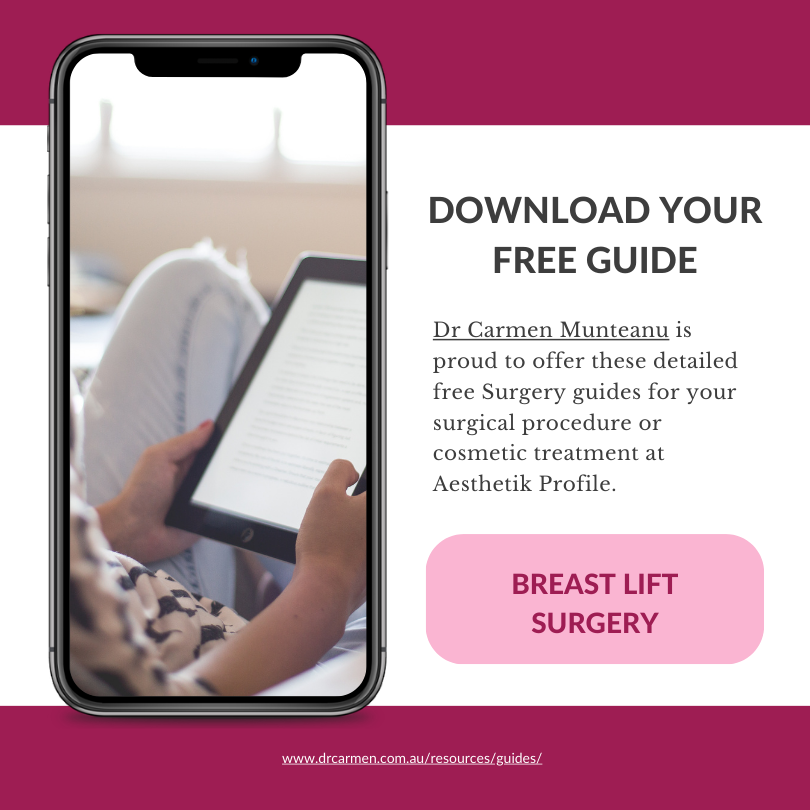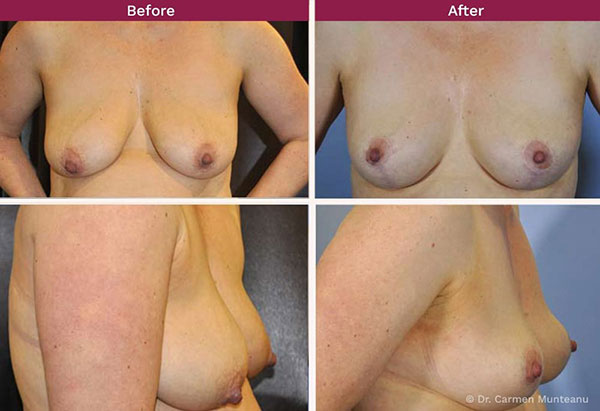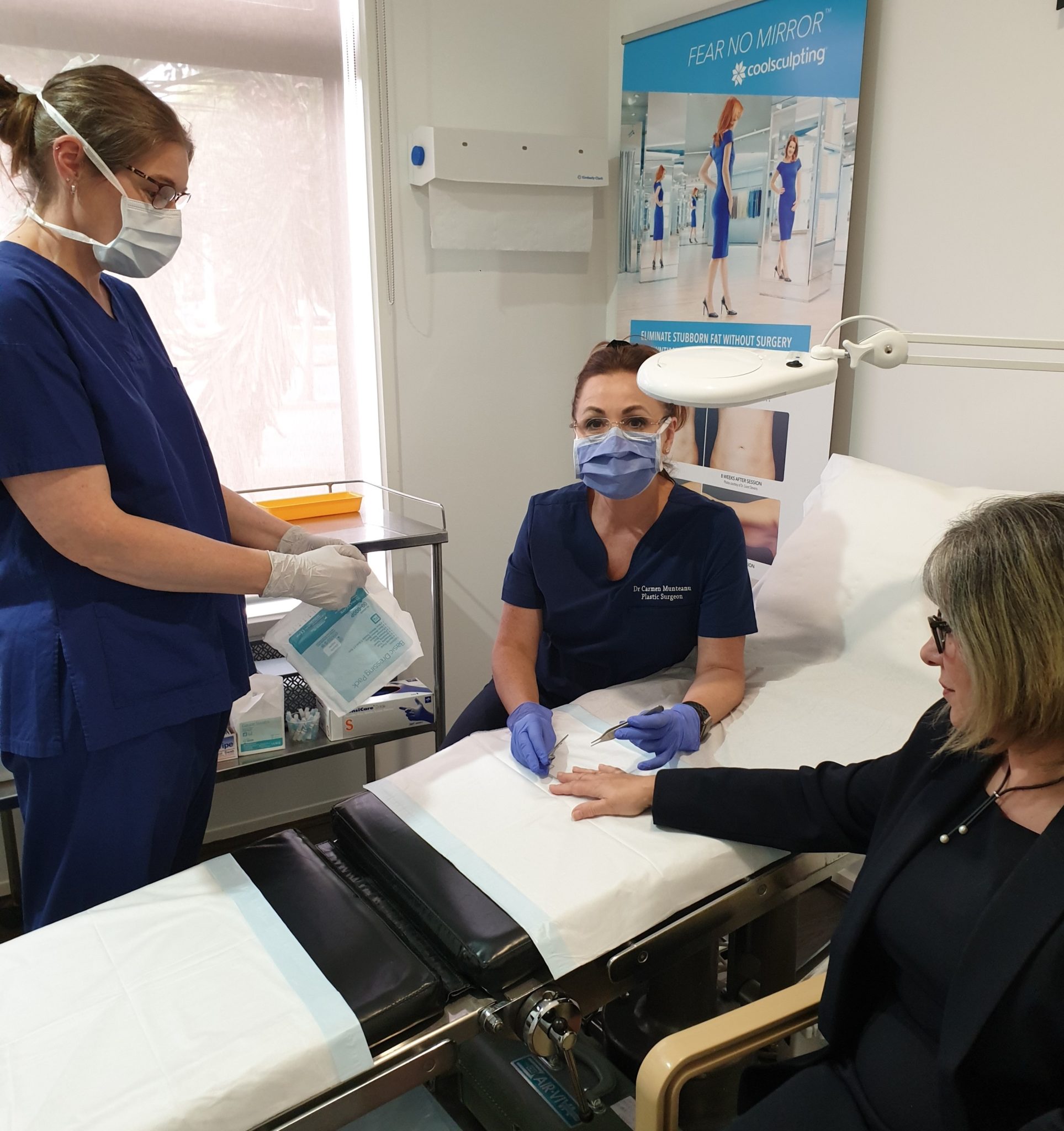How to Keep Bruising and Swelling under Control after a Breast Lift Surgery
Both swelling and bruising are the body’s tactical responses to trauma, in this case, surgical intervention. Swelling occurs as part of the inflammatory response, helping to isolate the affected area, thus preventing the spread of any potential harm. It also represents the local response to the surgical trauma. On the other hand, bruising results from diffusion of the blood accumulated in the surgical sites. The body tries to break them down in to essential products, which causes visible discolouration.
In this blog, Melbourne Specialist Plastic Surgeon Dr Carmen will explore effective strategies to manage and minimise the appearance of swelling and bruising, ensuring a more comfortable, efficient, and less stressful recovery period.
Download Dr Carmen’s Breast Lift Surgery – Mastopexy Guide

What Causes Swelling and Bruising after Breast Lift
When you undergo any form of surgical procedure, your body jumps into a protective mode, initiating a series of responses. Swelling and bruising are frontliners in this process, serving as tangible evidence that your body’s healing mechanisms are in operation. But what really sets off these reactions?
Surgery is a controlled form of trauma, and it’s this injury that triggers your body’s defence system. The area becomes inflamed – a cocktail of protective blood cells, nutrients, and antibodies rush in, and this is what causes swelling. It’s your body’s way of cushioning the area, ready to fight off any infection and start the healing process.
Bruising, the discolouration you see, comes from blood that’s leaked out of the vessels during surgery. When these tiny vessels or capillaries break, blood escapes and starts to pool under the skin, showing up as those blue, purple, or yellowish marks.
After surgery, your body goes into overdrive. This trauma response includes sending signal cells to the area to attract help, increasing blood flow, and setting off a chain of reactions that help prevent infection. It’s a complex, well-orchestrated event where every cell and protein has a part to play, and it all happens without you even realising it.
Role of Blood Vessels, Blood Clots, and Fluid Accumulation
Your blood vessels are like highways, transporting all sorts of essential materials to and from the site. When you’re healing, you want the right stuff – like oxygen and white blood cells – to get to where they’re most needed fast. That’s why you might notice the area feels warmer or looks redder, it’s due to this increased traffic.
Blood clots act like traffic cops, preventing major blood loss by forming a plug. They’re what helps stop the bleeding on the inside, ensuring you don’t lose too much blood.
Then there’s fluid accumulation. After surgery, your body sends extra fluid to the site, causing what you know as swelling. While it can feel uncomfortable, this process is intended to stabilise the area, keeping it secure as your body focuses on healing.

Methods to Reduce Swelling and Bruising after Breast Lift Surgery
Here are some methods to use if you want to minimise bruising and swelling:
Cold Compresses or ice packs
Introducing cold compresses to the affected area is a classic move in your recovery playbook, and for a good reason. Swelling and bruising don’t take well to the cold. Here’s why: cold temperatures constrict your blood vessels (a process known as vasoconstriction), reducing the flow of blood and other fluids into the area where you’ve had surgery. This reaction not only limits the intensity of swelling and bruising but also helps alleviate pain, making you more comfortable.
How to use cold compresses the right way: It’s simpler than you might think. Grab a cold pack or even a bag of frozen peas from the freezer. Wrap it in a cloth or towel – you don’t want to apply it directly to your skin. Hold the wrapped compress against the affected area for about 20 minutes. After that, give your skin a break for at least 40 minutes before you apply the cold again. Do this a few times a day, especially in the first 48 hours after surgery, and you’ll likely notice a difference.
Proper Rest and Elevation
Your body is a bit like a machine, and after any big event, like surgery, it needs a bit of downtime to recharge and repair. Rest is when your body gets its best work done. While you’re resting, your body focuses on repair, ensuring everything gets back to its best. By resting, you’re giving your body the best shot at a quick recovery, which means Swelling and Bruising won’t hang around longer than needed.
Why elevating the area makes a difference: Think of elevation as a bit of a helping hand. When you lift the surgery area, say by propping up with some pillows, you’re using gravity to your advantage. Fluid that might accumulate and cause swelling doesn’t get as much of a chance to settle. Instead, it’s encouraged to move away from the area. Less fluid means less of us, which is good news for you.
Compression Garments
Compression garments are specially designed to apply consistent pressure to the surgical area. This ‘squeeze’ performs a simple yet important task: it helps keep swelling down and prevents fluid from collecting at the site. By doing so, it not only enhances your comfort but also assists in shaping the area as it heals, contributing to a smoother contour in the aftermath of the procedure.
The pressure from these garments also plays a supportive role for your blood vessels, guiding the blood flow and reducing the likelihood of blood pooling and clot formation. This is essential in the healing stages, ensuring that the area receives a steady supply of nutrients while removing waste products through the blood.
Tips for Choosing the Right Garment
Selecting the proper compression garment is key to your comfort and recovery. Here are a few tips:
- Seek Recommendations: Dr Carmen knows the specifics of your procedure and recovery best. She can provide guidance on the most suitable type of garment for you
- Check the Fit: The garment should be snug but not painfully tight. It’s about balance – too loose, and you won’t receive the benefits; too tight, and you risk impairing your circulation
- Quality Matters: Opt for garments from reputable sources. They should be well-constructed with durable, stretchable fabric that provides consistent pressure while maintaining your comfort
- Easy Care: Post-surgery, you want the recovery process to be as smooth as possible. Choose a garment that’s easy to take on and off and is machine washable, as it’ll need to be cleaned regularly
Medication and Supplements
Recovery after a breast lift isn’t just about dealing with the physical aspects; it’s also about managing discomfort and reducing the likelihood of complications. While swelling and bruising are standard visitors during your recovery, you don’t have to host them without some assistance. Here’s how you can use medications and supplements to lessen their stay.
There are several over-the-counter (OTC) products that can help manage your comfort levels and influence swelling and bruising:
- Pain Relievers: Medications such as paracetamol can assist in managing discomfort. However, it’s essential to avoid aspirin or certain anti-inflammatory drugs (like ibuprofen), as they can increase bleeding
- Arnica: This natural supplement is popular for reducing bruising and swelling. Available in topical creams or oral forms, Arnica can help accelerate your body’s healing process
- Bromelain: Often found in pineapple juice and in tablet form, this enzyme is effective in reducing inflammation and swelling
What to Avoid to Prevent Increased Bleeding or Complications
The path to recovery is not just about what you do; it’s also about what you don’t do. Certain activities could invite swelling and bruising to linger, delaying your comfort and the final result you’re eager to see. Here’s a straightforward guide on what activities to sidestep during your recovery.
Physical Activities
After surgery, your body needs time to repair and regenerate. Engaging in strenuous physical activities disrupts this delicate process.
- High-Intensity Activities: Vigorous exercises or heavy lifting are off-limits initially. These can increase blood flow to the surgery area, exacerbating swelling and potentially leading to bleeding or more serious complications
- General Strain: Even household chores that involve bending, stretching, or strenuous movement should be avoided. Such actions can strain your incisions and internal stitches, slowing down your recovery
Remember, light walking and minor movements are encouraged to boost circulation.
Heat and Sun Exposure
Environmental factors play a role in your healing journey. Here’s why you should be cautious:
- Sun Exposure: UV rays can worsen your scars and increase skin sensitivity. Moreover, heat from the sun can intensify swelling, prolonging your recovery period
- High Temperatures: Hot baths, saunas, or any environment that raises your body temperature can increase swelling and discomfort. Stick to short, warm showers and cool environments
Adopt protective measures like wearing sunscreen if you have to be outdoors, but generally, try to stay in cool, shaded areas.
Foods and Drinks That Might Prolong Swelling and Bruising
Dietary choices can impact swelling and bruising. Some foods and drinks to reconsider include:
- Salty Foods: High sodium intake can cause water retention, worsening swelling. Opt for fresh foods and keep salt usage minimal
- Alcohol: Drinking can slow down your body’s healing mechanisms, prolonging the recovery phase. It can also increase swelling and bruising, so it’s best avoided
- Caffeine: Excessive caffeine can affect your circulation, potentially delaying healing. Try to limit your intake during recovery
FAQs about Swelling and Bruising after Breast Lift

How long will swelling and bruising last after my breast lift surgery?
- Swelling and bruising are common responses to surgery. Typically, most of the swelling subsides within the first few weeks following your procedure. However, it’s normal for minor swelling to persist for several months before you see the final contour of your breasts. Bruising usually fades more quickly, often disappearing after a couple of weeks. Everyone’s body heals at its own pace, so these timelines can vary.
Are there specific foods or drinks I should consume to help reduce swelling and bruising?
- Yes, your diet can impact your recovery. Foods rich in vitamins (like C and K) and bromelain and quercetin (found in pineapples and apples, respectively) can help reduce bruising and swelling. Try to increase your intake of fresh fruits and vegetables, lean proteins, and foods with anti-inflammatory properties. Stay hydrated with water, and avoid salty foods, as they can increase fluid retention, exacerbating swelling.
Is it normal to experience increased swelling in the evening?
- Yes, it’s common to notice an increase in swelling later in the day, particularly in the first few weeks after surgery. This phenomenon occurs due to the normal fluid accumulation that happens with increased activity throughout the day. Resting and elevating the affected area can help alleviate this type of swelling. If the swelling becomes significantly uncomfortable, it’s wise to contact Dr Carmen to rule out any complications.
Can I use over-the-counter medication to manage pain and swelling?
- While over-the-counter pain relievers can help manage discomfort, it’s essential to avoid medications that can increase bleeding, such as aspirin or certain anti-inflammatories.
When can I resume exercise after my breast lift surgery?
- Resuming physical activity depends on your personal healing progress and your plastic surgeon’s advice. Generally, patients can engage in light walking within a few days after surgery, which actually helps decrease swelling. However, you should avoid strenuous activities and exercises, especially those that involve the chest muscles, for at least six weeks or until Dr Carmen gives you the clearance to resume such activities.Top of FormBottom of Form
Further Reading about Breast Lift Surgery with Dr Carmen
- Read Dr Carmen’s Blog about How to Reduce Scars after Breast Lift
- Read Dr Carmen’s Blog about Recovery After Breast Lift Surgery – Tips, Timeline and Healing
- Read Dr Carmen’s Breast Lift without Implants Surgery Page
- Read Dr Carmen’s Blog about When Can I Exercise After Breast Lift Surgery
- Read Dr Carmen’s Blog about Sagging or Drooping Breasts? – Solutions for Breast Ptosis
- Read Dr Carmen’s Blog about How Can I Reduce Swelling and Bruising After Breast Lift
Medical References about Breast Lift
- Breast Lift (Mastopexy): Surgery & Recovery – Cleveland Clinic
- Breast Lift – Mayo Clinic
- Mastopexy (Breast Lift Surgery) – WebMD
- Breast Lift – Australian Society of Plastic Surgeon
- Mastopexy (breast lift) – NHS


